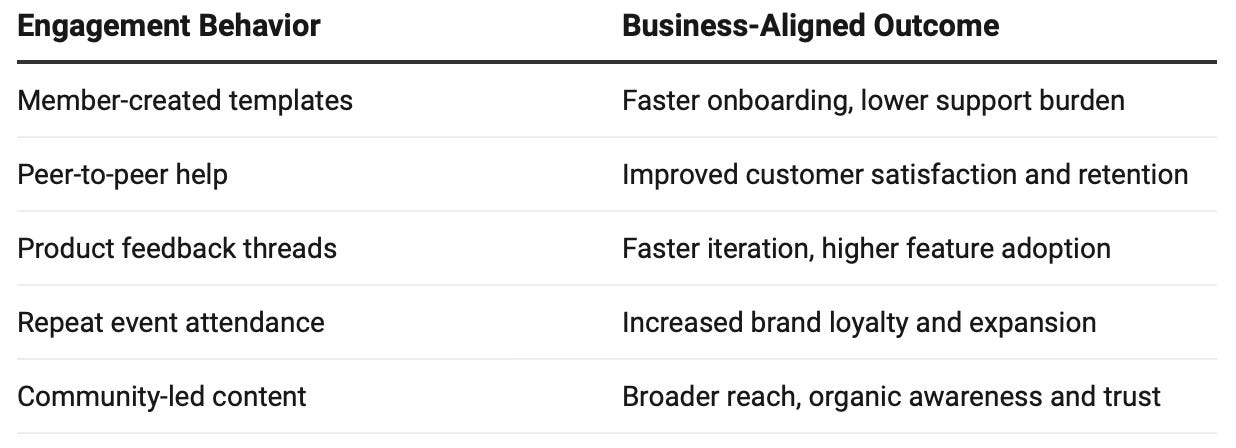How to Actually Measure Community Engagement (Beyond Vanity Metrics)
If your only engagement metric is “number of posts,” you’re not measuring a community—you’re measuring a group chat.
One of the most common questions I get from community pros and GTM leaders alike is:
How do we actually measure community engagement?
Let’s be honest: too many teams define community engagement by whatever’s easiest to track. Number of messages. Number of comments. Growth in monthly active users. The problem? These numbers might go up, but they don’t tell you what’s actually happening—or whether it’s meaningful.
It seems simple—more activity = more engagement, right? But when you peel back the layers, the answer is way more nuanced. That’s especially true when the loudest metrics (like number of posts or new members in Slack) don’t reflect what’s really going on or the real value your community is creating.
Recently, a reader told me they were asked to grow Slack messages in their community by the same percentage as their user base. Meanwhile, event attendance had doubled—but that didn’t count as a “win” because it didn’t show up in Slack. That kind of disconnect is exactly why this post exists.
Is your community healthy—or just busy?
It’s a question every community leader has faced. One that gets even murkier when the team upstairs is asking why post counts didn’t grow 10% last quarter.
Here’s the truth: You can’t measure the value of a community with a calculator and a content quota. If engagement metrics are the only thing you’re tracking, you’re not measuring community. You’re measuring noise.
So let’s talk about what engagement really looks like—and how to help your colleagues (and execs) understand it, too.
Engagement: it’s not just volume
Let’s start here: engagement isn’t a stat—it’s a signal. And like any good signal, it shows up in different ways across different touchpoints.
Think of your community as an ecosystem. Some people attend live events but never post in a forum. Others read every newsletter but never raise their hand. Some share your product with friends or create templates or tutorials on their own time.
If you’re only tracking the number of Slack messages, you’re missing the forest for the trees. True engagement shows up in participation, contribution, and connection—regardless of where it happens.
Some high-signal engagement behaviors:
Repeat event attendance (and event referrals)
Content creation: user blogs, templates, tutorials, etc.
Member-to-member support or collaboration
Community-generated product ideas or feedback
Advocacy: sharing, tagging, reviewing, or referring
Participation in surveys or beta tests
Resource downloads or engagement with learning content
Presence at key lifecycle stages (e.g., onboarding or expansion)
Notice the trend? Engagement isn’t always loud. Some of your most valuable members are what I call "quietly active"—they show up, learn, share, and support in ways that may not spike a Slack graph or light up your dashboards, but that drive real impact.
Engagement is an ecosystem
Here’s the nuance: Slack, Discord, or forum volume isn’t nothing. It’s just not everything.
In many communities, Slack or Discord becomes the most visible proxy for engagement. But it’s one signal among many. A thriving community might look quiet in Slack while being highly active in product forums, co-creation projects, AMAs, or meetups. Engagement needs to be viewed across the full ecosystem.
If event attendance is doubling but chat volume isn’t, that’s not a failure—it’s a sign that members are showing up in different ways. Maybe they prefer synchronous experiences. Maybe they’re moving into deeper, smaller group conversations off-platform. Maybe your Slack or Discord just isn’t the channel they trust most or that’s easiest or most enjoyable for them to participate in.
Great community leaders don’t just count activity—they interpret it. They spot the patterns that point to momentum or friction. They bring context. And they help leadership understand what the numbers really mean.
What leaders need to understand about engagement
If you’re an executive or GTM leader, here’s the reality: counting Slack messages isn’t going to tell you whether your community is driving business value. Engagement isn’t just chatter—it’s action, intent, and trust in motion.
When community managers ask you to shift away from post counts to a more nuanced view of engagement, they’re not dodging accountability. They’re trying to get closer to the truth and track what actually matters to your business.
Instead of asking, “Why didn’t posts increase by 10%?” ask:
Are we seeing deeper engagement over time from high-potential segments?
Is our community surfacing better product feedback, faster?
Are community insights informing GTM strategy or campaign messaging?
Are members moving from lurker to learner to leader?
Engagement can—and should—be tied to tangible outcomes: increased retention, greater share of voice, faster product adoption, and more efficient customer success. But that means shifting from volume to value.
What you actually want: translating engagement to business value
When your executive team asks for engagement metrics, what they usually want isn’t more chatter—it’s more clarity. They want to know: is this community helping us hit our business goals?
To answer that, map community behaviors to outcomes:
Activity ≠ health: What healthy communities actually look like
Let’s go back to that Slack example. The number of posts stayed flat, but event attendance doubled. Is that bad… or just different?
Not all growth is linear. And not all growth is good.
A mature community might post less—but with more quality. It might shift from async posts to live conversations. It might consolidate into smaller, high-signal groups. Or something else entirely.
Instead of chasing volume, look for signs of health:
Are members getting value and coming back?
Are they referring others?
Are they volunteering, sharing, or helping?
Are they participating across multiple touchpoints (not just one)?
Think of it like a gym: the number of grunts you hear doesn’t tell you if someone’s getting stronger. You need to look at consistency, improvement, and the ripple effects over time.
Real-world examples of engagement = business value
Here are a few companies measuring engagement in ways that matter (and generate real ROI):
Amplitude tracks engagement not just by forum chatter but by progress through its Product Analytics Academy. Community engagement is measured through certification completions, participation in cohort-based learning programs, and follow-ups into webinars and events. These aren’t just learning metrics—they’re indicators of product activation and customer stickiness.
Zapier sees engagement in user-generated workflows and shared templates. Their community isn’t just talking—they’re building and sharing automations. This drives product adoption, peer-led education, and deeper product integration across customer organizations.
Loom amplifies member-generated video content—how-to videos, use case walkthroughs, and tips for asynchronous communication. Community engagement shows up in how much customers teach one another. That’s not just connection—it’s organic enablement, driving product value realization at scale.
In each of these examples, what matters isn’t the quantity of posts or the size of the community. It’s whether engagement leads to business outcomes: retention, product mastery, and brand advocacy.
How to educate stakeholders who only want “growth” metrics
If you’ve been handed a goal like “increase posts by 15%,” you’re not alone. But part of your job is to guide the conversation.
Here’s how to start shifting the narrative:
Frame engagement in terms of business outcomes.“Instead of just looking at post volume, we’re tracking how often members help each other—because that reduces support tickets and increases retention.”
Tell stories with data.“We had 30% fewer posts last quarter, but our peer-to-peer replies doubled. We also saw a 40% increase in members signing up for events. We’re getting deeper, not just louder.”
Bring the human voice.“One member said: ‘I came for the product, but I stayed for the people.’ That’s the kind of emotional engagement that drives long-term loyalty.”
Use benchmarks, not absolutes.“For communities of our size, this participation rate is above average. Here’s how we’re trending compared to similar programs.”
Better ways to measure engagement: ideas you can steal
Here are some concrete engagement metrics worth exploring. You don’t need to track all of them—just start with what aligns to your goals:
Qualitative Signals
% of questions answered by peers
Top themes in member feedback
Number of user-generated resources (templates, videos, etc.)
NPS or satisfaction scores from community surveys
Behavioral Metrics
Event RSVP-to-attendance conversion
Average time between member touchpoints
Repeat participation across programs (events, forum, content)
Time-to-first contribution for new members
Strategic Metrics
Impact of community engagement on expansion/retention
% of high-value accounts with active community members
% of community members participating in beta/feedback
For some of these (especially strategic metrics, which are often the most valuable to a business), you may need to involve your data analytics team to connect community data to product or account data.
Measuring community engagement: decoded
Engagement isn’t about making noise. It’s about building momentum. And your job isn’t to chase empty activity—it’s to create the kind of spaces where participation feels meaningful, valuable, and self-sustaining.
If your community is helping members connect, learn, and grow—and you’re seeing that reflected in outcomes like retention, satisfaction, and brand affinity—you’re on the right track, even if the Slack posts aren’t skyrocketing.
And if leadership still wants “more posts”?
Well... now you’ve got a better story to tell.




